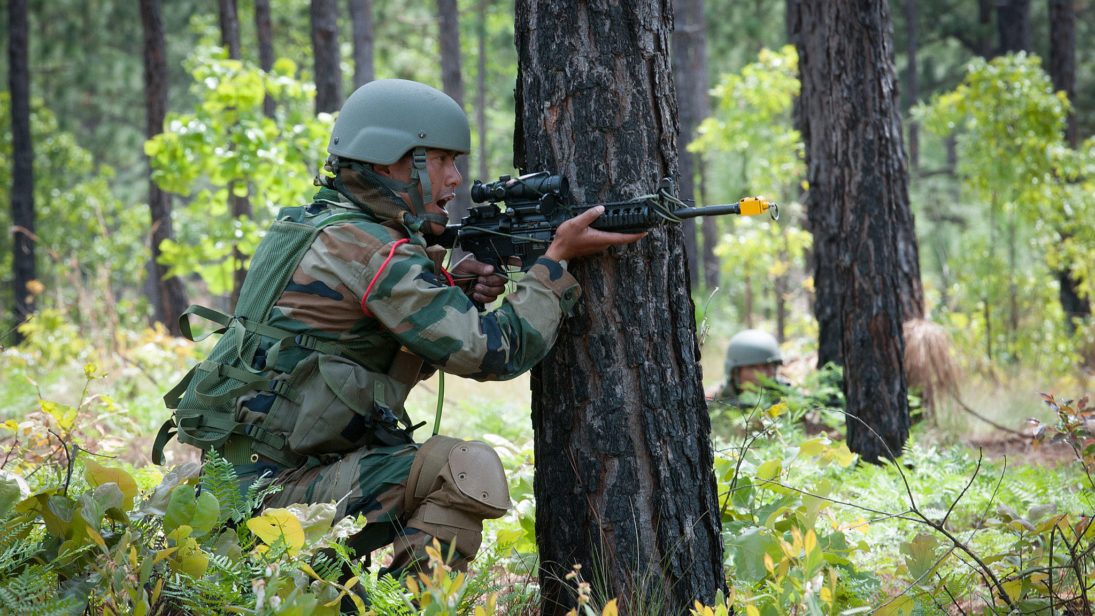
Army doctrines, which encapsulate a military service’s warfighting principles, act as a catalyst for experiments with new concepts and terminologies of complex security arrangements. The Indian army’s latest Land Warfare Doctrine (LWD), declassified in December 2018, is a crucial document which not only provides a lens with which to look into the Indian Army’s strategic thinking in a rapidly changing world, but also provides crucial insights about the army’s future plans to incorporate advanced technological applications to respond to multi-dimensional threats. It is important to assess the efficacy of this doctrine in the South Asian theater, where India and Pakistan share a violent history owing to territorial and political conflicts, including the frequent border skirmishes and the unresolved Kashmir dispute. Due to the LWD’s characterization of the existing force postures and unresolved disputes in the region, it can be concluded that the new LWD is squarely focused on Pakistan, and less oriented towards China.
Collusive Threat
The LWD, which is a follow-up of the Joint Doctrine of the Indian Armed Forces (JDIAF) released in 2017, starts with introducing the army’s engagement in multi-dimensional threats, both internal and external, as well as its firm resolve to respond to these threats in a future conflict scenario. In the rapidly changing regional security environment the LWD describes, the “collusive threat” from China and Pakistan is given priority. It states, “in event of a collusive threat, the primary front will be dealt with all the resources in our arsenal and a strong strategic defensive balance will be maintained along the secondary front.”
The LWD’s pledge to deal with “primary front” with “all resources” is a clear indication of India’s hard power pursuit in dealing with Pakistan while opting for a “defensive balance” against China.
Besides the LWD, the term “collusive threat” appeared previously in Indian Army Chief General Bipin Rawat’s speech at the Centre for Land Warfare Studies (CLAWS) think tank, where he mentioned that India must prepare for “two-front war.” But the LWD is not the first time that India has officially opposed the Sino-Pak cooperation: while referring to its passage through Pakistan administered Kashmir, the Indian Union Ministry in its official statement deemed the China-Pakistan Economic Corridor (CPEC) to be a threat to its national sovereignty. Even Prime Minister Modi in a meeting with Chinese Premier Xi Jinping in 2015 raised concerns over CPEC.
However, the LWD’s pledgeto deal with “primary front” with “all resources” is a clear indication ofIndia’s hard power pursuit in dealing with Pakistan while opting for a “defensivebalance” against China. From punitive strikes to techno-centric combat, the LWDaims to enhance contingency plans and military preparedness against Pakistan. Itinvolves quick mobilization of Integrated Battle Groups (IBGs) as well asemployment of interoperable equipment to deal with Pakistan. This is dangerousgiven the risks of escalation in nuclear environment.
The LWD is not a unique doctrine. Such Pakistan-centric military contingency plans have existed for long period of time. For several years, India’s politico-military leadership had denied the existence of a specific Cold Start Doctrine (CSD), until General Bipin Rawat blew the lid off the CSD in 2017 by admitting the existence of such “proactive strategy options.” Whether political leadership permitted General Rawat to publicly acknowledge the controversial term still remains unclear. However, after years of denial over CSD and later upon public endorsement of its existence, the Indian Army likely perceived it natural to unveil the further Pakistan-specific military options like the CSD in the LWD. While the LWD brings China into India’s threat perception, it aims to stay defensive on the China end while acting aggressively towards Pakistan – an indication of its specificity towards Pakistan.

MilitaryModernization in a Techno-centric Environment
The LWD aims to enhanceIndian capabilities to meet the threats of grey-zone and hybrid nature of wars(two distinctive features of compound warfare) through modernization andintegration of the armed forces. It pledges to cause unaffordable losses to thepotential adversaries in a multi-front scenario, which includes non-contactdomains of conflict including cyber, space, and information. Thus, under theLWD, the Indian Army will continue to modernize its force structure in bothsector-specific and threat-based manners.
To address the challenges of a techno-centric environment, the LWD envisions India’s mastery of technologically advanced and sophisticated weapon systems including artificial intelligence (AI), quantum computing, nanotechnology, hypersonic weapon systems and drone technology. This does not appear in the LWD alone: last month, while speaking at a national conference, General Rawat stressed the need to incorporate AI and big data analytics into the systems of the Indian armed services. With the passage of time, India will incorporate these technological tools to operate various self-regulatory combat systems equipped with AI, which includes military surveillance drones, combat robots, and other destabilizing autonomous high-speed weapons—all of which can potentially lead South Asia towards instability. Such courses of action hint towards India’s increasing assertiveness in both the conventional and subconventional domains of conflict and prepare India for limited scale conventional warfare.
India’s conventional superiority vis-a-vis Pakistan, its offensive force posturing along LoC, and its ambitions to equip army with latest war-machinery can potentially allow India to experiment with new warfare doctrines against its primary adversary.
Its increasing adeptness with such disruptive technologies may tilt the balance of power in India’s favor in a conflict. Pakistan is not in an economic position to compete with or neutralize a potential Indian buildup in these multiple domains of defense. The LWD gives India enough space for military and strategic maneuvering against Pakistan for the following reasons: first, in comparison to India’s massive spending in both the conventional and nuclear domains, Pakistan’s defense expenditures stand nowhere close. Evidence of this disparity is simple to locate: according to the most recently available data from the World Bank, India spent over $63 billion USD on its military in 2017, while Pakistan spent just over $10 billion USD in the same year. India’s conventional superiority vis-a-vis Pakistan, its offensive force posturing along LoC, and its ambitions to equip army with latest war-machinery can potentially allow India to experiment with new warfare doctrines against its primary adversary.
Pakistan’sResponse to the LWD
The LWD is not a meredoctrine. Rather, it is a comprehensive set of strategies and guidelines for theIndian Army to operate aggressively against Pakistan below the nuclearthreshold and maintain a defensive posture against China. Because the LWD appearsto be the product of an Indian Army focused on the Pakistan, it is quitenatural that much of the focus of LWD shall remain on Pakistan both in times ofpeace and war.
However, the LWD’s tough approach towards Pakistan may push South Asia towards nuclear brinkmanship. During a conflict with a militarily superior adversary, Pakistan would be forced to deal with advancing forces either through conventional means or by using short range low yield nuclear weapons. On January 24th and again a week later, Pakistan successfully conducted a training launch of the nuclear-capable surface-to-surface ballistic missile Nasr. This was aimed at countering India’s military offensive envisaged in its proactive strategy. This clearly indicates that, Pakistan is well aware of military developments in neighborhood and also prepared to deal with these eventualities. For that, Pakistan, without involving itself in an expensive nuclear and conventional arms race, will maintain a balance of power against India’s increasing assertiveness in the region by maintaining a robust deterrence equation.
Conclusion
In a nutshell, the LWD lays down broad contours for the Indian military to operate in a complex security environment which is unstable and often volatile due to periodic confrontation between India and Pakistan. The Indian Army’s ambitious plans to incorporate the latest technology in warfare planning and its pledge to prepare for a two-front war further complicates the South Asian security environment. But, given the complex nature of India-Pakistan bilateral dynamics, it’s more likely that Pakistan will bear the brunt of LWD.
Editor’s Note: This piece is the second of a two-part series on India’s Land Warfare Doctrine (LWD). Read the first article in the series, “Understanding India’s Land Warfare Doctrine,” by Ali Ahmed here.
***
Image 1: Fort Bragg via Flickr
Image 2: Sebastian Widmann via Getty


